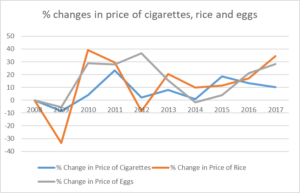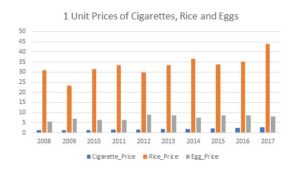
Background
Despite being a developing, low-middle income country, Bangladesh is the 8th largest cigarette market in the world[1]. Regardless of the economic benefit, a fact worth considering for public health and the economy is that the prices of cigarettes are relatively low compared to the prices of essential food commodities, making them affordable for smokers across all levels of income. According to the International Monetary Fund, the current per capita income is estimated at US$1,906, which has been showing an increasing trend over the years. Subsequently, the degree of affordability is also increasing accordingly. The rising prices of food items can sometimes be out of the reach of the common people. However, this is not the case for cigarettes, as cigarette price increases are not significant enough to render them unaffordable even for low-income people.
Objective
This study examines the varying trends in prices of food commodities over the past decade, and compare them with the price changes in cigarettes in the same years. The purpose of this exercise is to demonstrate the extent of the price increases of cigarettes compared to the rising prices of essential commodities such as rice and eggs. This study also tries to find out why cigarettes are relatively affordable and available on the market despite the government’s continuous effort to reduce smoking prevalence through taxation.
Data and Methods
This study is designed chiefly based on secondary data. The retail prices of 1 kg rice (BR -11, BR-8) and 4 farm eggs (red) were taken to represent the prices of essential food commodities. Rice is the staple food of Bangladesh and egg is considered as one of the most nutritious, still inexpensive foods. We took this particular variety of rice as the price is relatively lower than other varieties on the market and it is consumed mostly by the low-income families. The data were collected from the yearly Living Expenses and Relevant Consumer Affairs report published by the Consumers Association of Bangladesh (CAB) for 2008 to 2018.
On the other hand, for cigarettes we took the prices of Capstan cigarette (pack of 10 sticks) from the Statistical Yearbook of Bangladesh, for 2008 to 2018. A fact worth mentioning here is that all the data used in this study were collected from various government organizations, for ensuring the authenticity and reliability of this study. After accumulating all the necessary data, the percent changes in the prices of all three commodities were compared for measuring the extent of affordability of tobacco products in relation to essential food commodities. Additionally, the comparison between the price changes in 1 unit of each product is also shown in this study. This being a study based on secondary data, we were not able to buy cigarettes from the market and take the marginal retail price. As an alternative, we considered the price of a particular low-tier brand (Capstan).
Result
According to comparative analysis, the percent changes in price of cigarettes show a very insignificant rise in price in contrast to the visible price increases for rice and eggs, which are consumed daily by the majority population unlike harmful products such as cigarettes.

Figure 1: % changes in prices of cigarttes (Capstan), rice and eggs
In figure 1, we can see that from 2008 to 2017, the percent change in retail prices of all three products shows an increasing trend to a certain degree. Yet, the price changes in cigarettes had been considerably lower than that of the food items over the years, causing cigarettes to be available for anyone who wants to smoke, regardless of income level or age.
In a more empirical approach, the average price changes from 2016 to 2017 shows 24% price increase in the prices of rice, where the prices of cigarettes increased by a mere 10%, indicating that the price discrepancies are following the same trend where price increases in cigarettes are substantially lower than the price changes of daily necessities.

Figure 2: Unit prices of cigarette (Capstan), rice and eggs
From comparing the prices of 1 unit of each product (1 stick of cigarette, 1 kg rice and 1 egg), it can clearly be seen that the prices of cigarettes have been considerably lower than that of rice and eggs over the years. 1 stick of cigarette costs moderately less than 1 egg or 1 kg of rice, as shown in figure 2. For anyone earning the minimum wage, purchasing a loose cigarette is much easier than purchasing the daily necessities for their families. Which in many ways contradicts the Framework Convention on Tobacco Control, namely by spreading the smoking prevalence among general people and condoning the effects of exposure of secondhand smoke in women and children.
What can be discerned from this analysis is that because of the market mechanism, the demand of cigarettes shows comparatively low responsiveness to price increases, because the increased prices are still not too overpriced for people. Consequently, the market for cigarettes stay relatively stable compared to the market for essential food commodities, making cigarettes affordable anytime. The conclusion of this analysis is that with the existing pricing mechanism of cigarettes, they will always be accessible to low-income people despite being injurious to health.
Discussion
A study conducted by the Ministry of Health and Family Welfare in India shows almost the same phenomenon happening in our neighboring country. The study considers the wholesale prices of tobacco products (both smoking and smokeless) and compare them with that of the essential commodities such as food. The study also sheds light on the ineffectiveness of the complicated tobacco tax structure in India regarding tobacco control, a finding that almost explicitly applies to Bangladesh as well.
Following this argument, it can be inferred that both the countries are facing the same situations regarding the affordability and availability of tobacco products due to complex tax structures. The most ideal solution to address the situation is to bring effective changes in the tax structure of tobacco products.
Policy Recommendations
To reduce the smoking prevalence across all levels of income and making cigarettes not as affordable as any essential commodity, the government to should consider undertaking the following measures:
- Simplify the existing multi-tiered ad valorem tax structure by amending the current law.
- Incorporate specific tax on cigarettes along with the existing ad valorem tax structure.
- Strengthen the entire process of implementation and administration of revenue collection of cigarettes. In order to achieve this, related government officials must be trained and sensitized accordingly about the importance of reducing tobacco consumption in Bangladesh.
Be committed to work against TII (Tobacco Industry Interference) with complete effort and dedication
[1] https://www.dhakatribune.com/opinion/op-ed/2018/12/24/how-will-jti-s-investment-affect-the-cigarette-market
Author: Aadeeba Kaareen, Research Assistant (Tobacco Tax Project), Bureau of Economic Research, University of Dhaka

